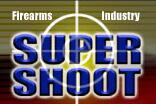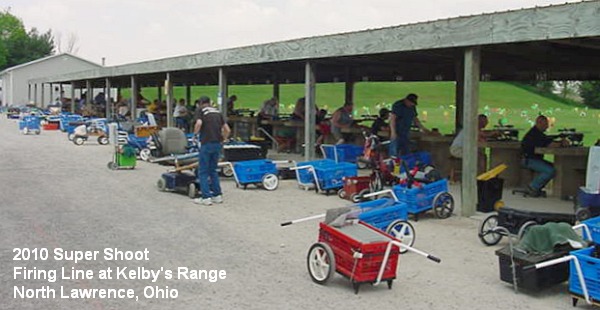Firearms Industry Super Shoot Set for May 22-25
 Ready for the Super Shoot? The 41st Annual Firearms Industry Super Shoot will be held on May 22-25, 2013, at Kelbly’s Rifle Range in North Lawrence, Ohio. This annual event draws some of the best 100-yard and 200-yard benchrest shooters in the world. Last year’s Super Shoot had almost 300 competitors from the USA and 14 other countries (about 15% of the competitors come from overseas).
Ready for the Super Shoot? The 41st Annual Firearms Industry Super Shoot will be held on May 22-25, 2013, at Kelbly’s Rifle Range in North Lawrence, Ohio. This annual event draws some of the best 100-yard and 200-yard benchrest shooters in the world. Last year’s Super Shoot had almost 300 competitors from the USA and 14 other countries (about 15% of the competitors come from overseas).
2012 Super Shoot Highlights Video (Watch This — It’s Very Well Done!)
If you’ve never attended the Super Shoot before, and don’t know what to expect, former Sinclair International President Bill Gravatt offers some insights into this great event:
Super Shoot — What It’s All About
The excitement and anticipation leading up to a Super Shoot can be hard to explain to those who haven’t been to one. Every year, some shooters arrive at the Super Shoot a week early to dial in their rifles, learn wind conditions for the range, and enjoy the camaraderie of their fellow shooters. As the match draws closer, campers and RVs fill the area behind the range, and shooters stake out turf all over the property with their reloading and cleaning equipment setups.
Many shooters choose to load cartridges in the main barn directly behind the 60-bench firing line, while others decide to work in pop-ups, campers and other outbuildings around the facility. Benchrest shooters tend to load in small batches, and some most load cartridges between each match. Many shooters clean their rifles after each match, while others sometimes go two or three matches between cleanings, depending on the number of rounds they fire.

Another part of high-level benchrest competition that will amaze first-time attendees is the quality and amount of equipment benchrest shooters use. Just in front of the shooting benches and the targets, range flags of all kinds sprout up, from the typical “daisy wheel” flags to very sophisticated velocity indicators that show varying wind intensity. Shooters adjust their flags to align with the particular target in front of a specific bench, just slightly below the path of the bullet but still partially visible in the high-powered scopes.
The rifles represent a variety of actions, usually custom, with heavy benchrest barrels by various barrel makers. The most popular cartridge used is the 6mm PPC, but occasionally you will run into someone using a 6mm BR or a slightly modified 6mm BR, and as well as a few other cartridges. Rifle rests used are typically heavy tripods or plate rests. You see a lot of Sinclair rests, Farley rests, and a variety of others, including a few homemade rests. Bags are typically Edgewood or Protektor.
Super Shoot — Runners, Pickers and the Pursuit of Perfection
The techniques vary between shooters, and they are interesting to observe. Some shooters “run” their targets and will shoot a quick sighter and then run all 5 shots as fast as they can before conditions change. Others are “pickers” and shoot each shot carefully, going back and forth between the record target and the sighter target to verify wind conditions and bullet drift. These guys will sometimes shoot up to 10 sighters and use the full seven minutes. Both styles of shooting work and many shooters use both techniques depending on the match conditions[.]Anyone who attends the Super Shoot will come away with a greater appreciation of precision benchrest shooting. Experienced benchresters already know there will be windy days that drive them crazy, and less experienced shooters can get completely lost when… holding off a shot in the wind. But the reward is worth it. It’s very satisfying to hold off a full inch at 100 yards because the wind changes during your string and drop your fifth shot into a sub 0.100″ group with only seconds remaining on the clock. And that’s what the Super Shoot is all about.
The Super Shoot begins with the Light Varmint Class, for guns that weigh 10.5 lbs or less, and consists of a Warm-Up match and five Registered Matches at 100 yards. Shooters are assigned to one of at least six relays and rotate through 12 benches between each of the registered matches. The rotation ensures each shooter faces various wind conditions found at different parts of the range. Competitors can fire an unlimited amount of sighter shots into the sighter target square. The shooters use these sighters to check changes in wind conditions and determine the amount of hold-off, if necessary.

Once the match starts and the “Commence Fire” command is given, shooters have seven minutes to fire five shots into the record target square. These five shots comprise their “group” score for the match. The groups are gauged using a target measuring device with a magnifier and measures the two outermost shots in the group from center point to center point. This group size is the shooter’s score for that match. The laymen’s way to calculate group size is to measure outside edge to outside edge and subtract the bullet diameter. Both procedures achieve roughly the same results. The group sizes for the five record matches comprise their 100 yard Light Varmint Aggregate. Obviously, the smallest aggregate wins.
The second day repeats the process, only competitors are shooting the Heavy Varmint Class rifles, weighing up to 13.5 lbs, at 100 yards. On the third day, the targets are moved to 200 yards and the Heavy Varmint Class is shot at that yardage. The reason for staying with the Heavy Varmint Class is that shooters who switch to heavier barrels can leave them on after shooting 100 yards. On Saturday, the final day of the match, the shooters compete with the Light Varmint guns at 200 yards.
There are winners for each yardage and gun: Light Varmint 100, Light Varmint 200, Heavy Varmint 100, and Heavy Varmint 200. There are also winners for each gun with the two yardages combined. The grand champion of the shoot is the Two-Gun Champion who has the lowest overall group aggregate for the four days of shooting.

For more information, email jim[at]kelbly.com or call (330) 683-4674. You can register onsite (at the Kelbly’s range) or CLICK HERE for 2013 Super Shoot Registration Form. NOTE: After May 10, 2013 registration fees are $130 per gun — no exceptions.














 Carter enrolled in a series of Long-Range Marksmanship courses under the guidance of
Carter enrolled in a series of Long-Range Marksmanship courses under the guidance of  The first day of the Long Range III course, rifles were sighted-in at 500 yards and students engaged targets at 1200 yards. On Day 2 a cold front and driven snow made shooting near impossible. So, on the third and last day, Carter and the other students decided to go out as far as possible.
The first day of the Long Range III course, rifles were sighted-in at 500 yards and students engaged targets at 1200 yards. On Day 2 a cold front and driven snow made shooting near impossible. So, on the third and last day, Carter and the other students decided to go out as far as possible.





